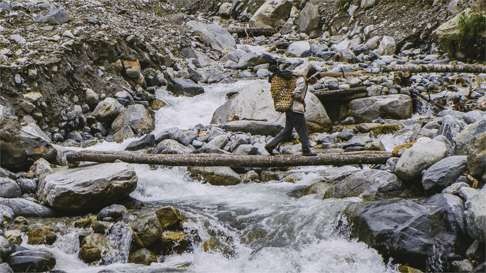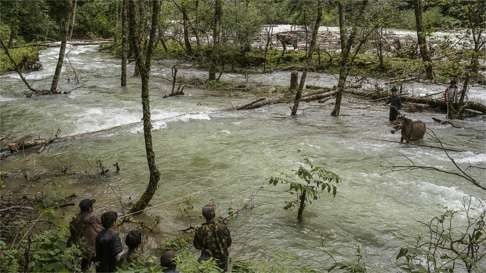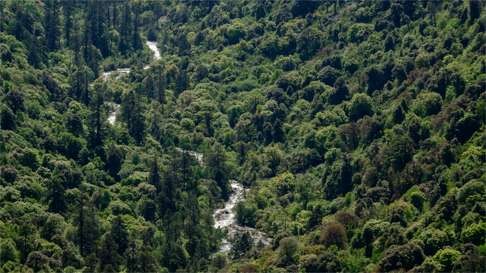
Beat the rush to China’s last tourism frontier – remote Dulong Valley
Hong Kong ultrarunner Pavel Toropov explores a high-altitude gorge near the China-Myanmar border. Home to some of China’s last primary forests, it is earmarked for mass tourism; enjoy it while you can
I first heard about the Dulong Valley from a trekking guide who had just taken a group there. He described it as stunning, with sheer, jungle-covered gorges rising straight to snow-capped peaks above. He also complained about bugs, snakes and near impenetrable terrain, but intrigued, I decided to make Dulong the final destination of a 400km solo exploration run I did last year from Shangri-la in Yunnan province, southwest China.
The Dulong River flows into Myanmar, where it is called the N’Mai, and is one of the headstreams of the Irrawaddy River which flows south through Myanmar and Bangladesh. Its inaccessibility and remoteness have kept it pristine until recently, and the lush, humid forests at the bottom of its deep valley are one of the most biodiverse places in China. Culturally and ethnically, it is closer to Myanmar than China; the local ethnic minorities – the Dulong (also called Derung or Drung) and the Nu live on both sides on the border, and many still follow a traditional lifestyle based on fishing, hunting and forest agriculture.
This lifestyle is now dying out, as this unique corner of Yunnan has finally succumbed to the juggernaut of China’s development. The almost complete isolation of Dulong ended in 1999 when a road was built and authorities announced the “opening up of China’s last ethnic minority area”.
Last year a tunnel was built, making the valley accessible all year round. The Dulong people are encouraged to relocate to housing provided free of charge by the state and are given food subsidies, so they are losing their knowledge of sustainable agro-forestry, built up over centuries.
Billions of yuan has been poured into infrastructure investment, which has brought ever more people, vehicles, pollution and refuse.

Real adventure tourism is just starting in the Dulong Valley, however, and you will feel like an explorer the moment you step off the road and into the forest. Be warned; hiking here requires planning, equipment and preferably the services of a local guide, and the river is only for very experienced kayakers.
The terrain can be extremely steep, creepy-crawlies are thick on the ground, the weather can change in a blink of an eye, and it is very easy to get lost. An interesting and easier option is to cycle to the Dulong, camping on the way or staying in cheap local hotels.
Getting there:
To get to Dulong from Hong Kong, fly to Baoshan via Kunming. From there take a bus to Gongshan,(then a shuttle van to Fugong, from where another van will take you to Dulong Township. Another option is to arrange for a driver and vehicle in Fugong (about 700 yuan per day, plus driver’s food and lodging). Do not expect anyone to speak English in any of these places. The very small Dulong Township has several new hotels, with more opening soon.
IN PICTURES: the Dulong Valley

A young man crosses a stream where a large landslide came through a few days earlier. Landslides and river bank collapses are common in the rain-soaked Dulong Valley.

The practice of tattooing girls’ faces was designed to prevent them from being kidnapped by Tibetan bandits raiding Dulong from the north. After the establishment of the People’s Republic this practise was banned, and now only a very few tattooed women remain. This one, a practising Catholic, was travelling to the township on business.

Extremely difficult to get to, especially in the rainy season, Mudang Village requires a five-hour drive north from Dulong Township followed by a 50km hike. The trail is extremely tough and dangerous, with many crossings of deep streams and scrambling up steep mountainsides. Here caravan drivers are trying to get a terrified mule across a swollen stream.

Not a scrap of food is wasted in remote Xianghongcun Village, where dogs lick the table clean after the family has finished eating. The villagers live by fishing, collecting wild herbs, raising livestock and growing basic crops. Hunting is now officially banned, but may locals still have home-made guns and continue this tradition.

The lower Dulong Valley seen from the main highway connecting Dulong with the rest of China.

An old woman of Dulong (Derung) ethnicity in Xianghongcun Village. She is the last remaining woman with facial tattoos left here. I have no idea how old she is; she could not speak one word of Chinese.

Ultra-runner, translator, writer and tour guide Pavel Toropov stands in the waters of the Dulong, which are as cold as they are blue. He covered more than 400km in eight days, with over 24,000 metres of elevation gain and loss, reaching altitudes as high as 4600 metres.

